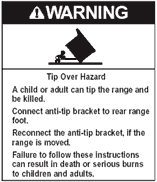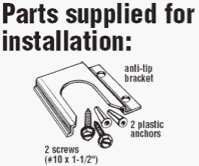Anti-Tip Brackets for Freestanding Ranges
by Nick
Gromicko and Kenton Shepard

Anti-tip
brackets are metal devices designed to prevent freestanding ranges
from tipping. They are normally attached to a rear leg of the range
or screwed into the wall behind the range, and are included in all
installation kits. A unit that is not equipped with these devices may
tip over if enough weight is applied to its open door, such as that
from a large Thanksgiving turkey, or even a small child. A falling
range can crush, scald, or burn anyone caught beneath.
Bracket
Inspection
Inspectors
can confirm the presence of anti-tip brackets through the following
methods:
- It may be possible to see a wall-mounted bracket by looking over the rear of the range. Floor-mounted brackets are often hidden, although in some models with removable drawers, such as 30-inch electric ranges made by General Electric, the drawers can be removed and a flashlight can be used to search for the bracket. Inspectors should beware that a visual confirmation does not guarantee that the bracket has been properly installed.
- Inspectors can firmly grip the upper-rear section of the range and tip the unit. If equipped with an anti-tip bracket, the unit will not tip more than several inches before coming to a halt. The range should be turned off, and all items should be removed from the stovetop before this action can be performed. It is usually easier to detect a bracket by tipping the range than through a visual search. This test can be performed on all models and it can confirm the functionality of a bracket.
If no
anti-tip bracket is detected, inspectors should recommend that one be
installed.
 Clients
can contact the dealer or builder who installed their range and
request that they install a bracket. For clients who wish to install
a bracket themselves, the part can be purchased at most hardware
stores or ordered from a manufacturer. General Electric will send
their customers an anti-tip bracket for free.
Clients
can contact the dealer or builder who installed their range and
request that they install a bracket. For clients who wish to install
a bracket themselves, the part can be purchased at most hardware
stores or ordered from a manufacturer. General Electric will send
their customers an anti-tip bracket for free.
According
to the U.S. Consumer Product Safety Commission (CPSC), there were 143
incidents caused by range tip-overs from 1980 to 2006. Of the 33
incidents that resulted in death, most of those victims were
children. A small child may stand on an open range door in order to
see what is cooking on the stovetop and accidentally cause the entire
unit to fall on top of him, along with whatever hot items may have
been cooking on the stovetop. The elderly, too, may be injured while
using the range for support while cleaning.
In
response to this danger, the American National Standards Institute
(ANSI) and Underwriters Laboratories (UL) created standards in 1991
that require all ranges manufactured after that year to be capable of
remaining stable while supporting 250 pounds of weight on their open
doors. Manufacturers' instructions, too, require that anti-tip
brackets provided be installed. Despite these warnings, retailer
Sears estimated in 1999 that a mere 5% of the gas and electric units
they sold were ever equipped with anti-tip brackets. As a result of
Sears’ failure to comply with safety regulations, they were sued
and subsequently required to secure ranges in nearly 4 million homes,
a measure that has been speculated to have cost Sears as much as $500
million.
In
summary, ranges are susceptible to tipping if they are not equipped
with anti-tip brackets. Inspectors should know how to confirm that
these safety devices are present.
No comments:
Post a Comment